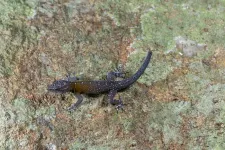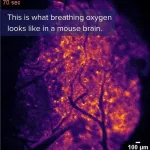(Press-News.org) DETROIT - A groundbreaking study published in the journal iScience presents crucial insights into the ocular effects of Zika virus infection during pregnancy and offers promising avenues for therapeutic intervention.
Produced by a team of researchers in the Department of Ophthalmology, Visual and Anatomical Sciences at the Wayne State University School of Medicine, the paper, “Targeting ABCG1 and SREBP-2 mediated cholesterol homeostasis ameliorates Zika virus-induced ocular pathology,” provides compelling evidence of the involvement of cholesterol metabolism in ZIKV-related eye abnormalities.
Zika virus, or ZIKV, has emerged as a public health threat and poses significant challenges to reproductive health worldwide. While congenital ZIKV infection has been shown to cause neurological disorders, primarily microcephaly – abnormal shrinking of the head circumference – several clinical studies have linked ZIKV to ocular deformities in infants. These include retinal lesions, microphthalmia, hemorrhagic retinopathy, retinal pigmented epithelium mottling, optic neuritis and hypoplasia of the optic nerve.
Despite the ZIKV infection causing severe neurological and ocular abnormalities in infants, no specific vaccines or antiviral treatments are available. In their research, the team conducted a transcriptomic analysis of ZIKV-infected retinal pigment epithelial (RPE) cells, revealing significant alterations in the cholesterol pathway.
“Our study aimed to uncover the molecular mechanisms underlying ZIKV-related eye abnormalities, with a focus on cellular metabolism,” said Ashok Kumar, Ph.D., professor of ophthalmology, visual and anatomical sciences, and senior author of the study. “By elucidating the roles of key players in cholesterol metabolism, we sought to identify potential targets for therapeutic intervention.”
The researchers investigated the functional roles of ATP-binding cassette transporter G1 (ABCG1) and sterol response element binding protein 2 (SREBP-2), two critical regulators of cholesterol metabolism, during ocular ZIKV infection. Their cell culture experiments demonstrated that increased ABCG1 activity, mediated via liver X receptors (LXRs), led to reduced ZIKV replication, while inhibition of SREBP-2 reduced viral replication by lowering cholesterol levels.
In vivo studies using mouse models of ZIKV-induced chorioretinal lesions revealed that treatment with an LXR agonist or SREBP-2 inhibitor mitigated ocular abnormalities associated with ZIKV infection. These treatments were accompanied by decreased expression of inflammatory mediators and increased activation of antiviral response genes.
“This study highlights the intricate interplay between cholesterol metabolism and ZIKV infection in the eye,” explained Sneha Singh, Ph.D., a postdoctoral fellow in Kumar’s lab. “Our findings suggest that targeting cholesterol pathway components, such as ABCG1 and SREBP-2, could offer promising therapeutic strategies for mitigating ZIKV-induced ocular complications.”
“The implications of our study extend beyond Zika virus, as the mechanisms uncovered can potentially apply to other enveloped viruses such as West Nile virus, Japanese encephalitis virus and Dengue virus,” Kumar said.
Kumar’s team is utilizing a lipidomics approach to pinpoint lipid molecules possessing both proviral and antiviral properties, with the overarching goal of unearthing novel antiviral therapeutics.
The publication of this paper underscores Wayne State’s commitment to advancing scientific knowledge and addressing pressing global health challenges. The interdisciplinary collaboration and innovative methodologies employed in this research exemplify the institution’s dedication to excellence in scientific inquiry.
“Through the innovative research team that Dr. Kumar has established, they are at the forefront of developing breakthroughs that will play a vital role in therapeutic interventions in eye abnormalities caused by the Zika virus,” said Ezemenari M. Obasi, Ph.D., vice president for research at Wayne State. “This study is an excellent example of how Wayne State’s research is making discoveries that can impact lives in Detroit and around the world.”
The paper is now available online in iScience and can be accessed at 10.1016/j.isci.2024.109088.
This research was made possible through funding from the National Institutes of Health’s National Eye Institute (Grants: R21AI135583, R01EY026964, 1R01EY032149-01 and R01 EY027381).
###
About Wayne State University
Wayne State University is one of the nation’s pre-eminent public research universities in an urban setting. Through its multidisciplinary approach to research and education, and its ongoing collaboration with government, industry and other institutions, the university seeks to enhance economic growth and improve the quality of life in the city of Detroit, state of Michigan and throughout the world. For more information about research at Wayne State University, visit research.wayne.edu.
END
You’ve probably seen nature depicted in art, but how often do you see an artwork hiding in nature?
When they saw the back of a lizard in the Southern Western Ghats, a group of scientists from the Thackeray Wildlife Foundation in India were reminded of Van Gogh’s The Starry Night. As soon as they figured out it was a new species, it was only apt to name it in honour of the famous painter.
“Cnemaspis vangoghi is named for Dutch painter Vincent Van Gogh (1853–1890) as the striking colouration of the new species is reminiscent of one of his most iconic paintings, The ...
Hyenas are generalist predators (and scavengers) with a broad range of prey species. They are known for hunting (or scavenging) larger mammals such as antelopes and occasionally feed on smaller mammals and reptiles. Being flexible in the choice of prey is a strategy of generalists – and this even extends to small passerine birds, as scientists from the Leibniz Institute for Zoo and Wildlife Research (Leibniz-IZW) and the University of Ljubljana observed in Namibia: Spotted hyenas pursued red-billed queleas, picked them from the ground or the surface of a waterhole and swallowed them whole, at a success rate of approximately one bird every three minutes. These observations were described ...
Using a bioluminescent oxygen indicator, Felix Beinlich and colleagues discovered a spontaneous, spatially defined occurrence of “hypoxic pockets” in the mouse brain. Their technique offers a way to learn more about brain oxygen tension (pO2), a measure of oxygen delivery and demand in brain tissue that changes dynamically but is not well understood. The findings could have implications for how rest and exercise affect pO2 in the human brain, including the role of these activities in conditions such as dementia, Beinlich et al. suggest. The researchers used a genetically encoded bioluminescent oxygen indicator called Green NanoLuc in mouse cortical astrocytes to ...
The dissolved organic matter (DOM) from hundreds of plant and animal remains could be used to track and possibly restore the health of freshwater bodies, Andrew J. Tanentzap and Jérémy A. Fonvielle write in this Perspective. The broad range of compounds, or chemodiversity, of DOM has multiple effects in freshwaters, including providing nutrients to support food web productivity, reducing or enhancing contamination from pollutants, and influencing the metabolism of microorganisms important to the biogeochemical cycle. DOM may also reduce the heat that ...
There should be mandatory indoor air quality standards, say an international group of experts led by Professor Lidia Morawska.
Professor Morawska, Vice-Chancellor Fellow at the University of Surrey and Distinguished Professor at Queensland University of Technology, led the appeal to the World Health Organization to recognise the airborne transmission of the virus which causes COVID-19 early in the pandemic – and help minimise it.
Now, in a paper published by the prestigious journal Science, Professor Morawska's international team recommends setting standards for ventilation rate and three key indoor pollutants: carbon ...
Women affected by premenstrual disorders have a higher risk of perinatal depression compared with those who do not, according to research published March 28th in the open access journal PLOS Medicine. The relationship works both ways: those with perinatal depression are also more likely to develop premenstrual disorders after pregnancy and childbirth. This study suggests that a common mechanism might contribute to the two conditions.
Menstruating women experience cyclical hormone fluctuations through puberty, menstrual cycle, pregnancy ...
The human brain consumes vast amounts of energy, which is almost exclusively generated from a form of metabolism that requires oxygen. Consequently, the efficient and timely allocation and delivery of oxygen is critical to healthy brain function, however, the precise mechanics of this process have largely remained hidden from scientists.
A new bioluminescence imaging technique, described today in the journal Science, has created highly detailed, and visually striking, images of the movement ...
All plants mediate their environmental interactions via chemical signals. An example is the alkaloid gramine produced by barley, one of the world’s most widely grown cereals. Gramine provides protection against herbivorous insects and grazing animals and inhibits the growth of other plants. Despite long-standing interest, the key gene for the formation of gramine remained elusive.
The researchers discovered a cluster of two genes in barley for gramine biosynthesis. The first gene (HvNMT) had already been discovered 18 years ago. In their study the researchers from IPK and the Leibniz University Hannover now identified a second gene (AMI synthase, HvAMIS), and ...
The source of pollutants in rivers and freshwater lakes can now be identified using a comprehensive new water quality analysis, according to scientists at the University of Cambridge and Trent University, Canada.
Microparticles from car tyres, pesticides from farmers’ fields, and toxins from harmful algal blooms are just some of the organic chemicals that can be detected using the new approach, which also indicates the impact these chemicals are likely to have in a particular river or lake.
Importantly, the approach can also point to the origin of specific organic matter dissolved in the water, because it has a distinct ...
Women with premenstrual syndrome (PMS) or premenstrual dysphoric disorder (PMDD) have a higher risk of perinatal depression. Conversely, women with perinatal depression have a higher risk of developing premenstrual disorders. This is shown in a study from Karolinska Institutet published in the journal PLOS Medicine.
Premenstrual disorders like PMS or PMDD and perinatal depression are similar in the way that symptoms appear in connection with hormonal changes. This fact has given rise to the hypothesis ...







